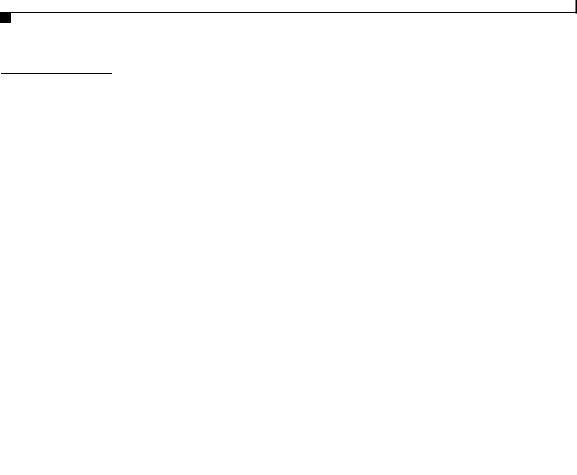Cisco OL-8241-02 User Manual

Cisco Content Services Switch
Routing and Bridging Configuration
Guide
Software Version 8.20
November 2006
Corporate Headquarters
Cisco Systems, Inc. 170 West Tasman Drive
San Jose, CA 95134-1706 USA http://www.cisco.com Tel: 408 526-4000
800 553-NETS (6387) Fax: 408 526-4100
Text Part Number: OL-8241-02
THE SPECIFICATIONS AND INFORMATION REGARDING THE PRODUCTS IN THIS MANUAL ARE SUBJECT TO CHANGE WITHOUT NOTICE. ALL STATEMENTS, INFORMATION, AND RECOMMENDATIONS IN THIS MANUAL ARE BELIEVED TO BE ACCURATE BUT ARE PRESENTED WITHOUT WARRANTY OF ANY KIND, EXPRESS OR IMPLIED. USERS MUST TAKE FULL RESPONSIBILITY FOR THEIR APPLICATION OF ANY PRODUCTS.
THE SOFTWARE LICENSE AND LIMITED WARRANTY FOR THE ACCOMPANYING PRODUCT ARE SET FORTH IN THE INFORMATION PACKET THAT SHIPPED WITH THE PRODUCT AND ARE INCORPORATED HEREIN BY THIS REFERENCE. IF YOU ARE UNABLE TO LOCATE THE SOFTWARE LICENSE OR LIMITED WARRANTY, CONTACT YOUR CISCO REPRESENTATIVE FOR A COPY.
The Cisco implementation of TCP header compression is an adaptation of a program developed by the University of California, Berkeley (UCB) as part of UCB’s public domain version of the UNIX operating system. All rights reserved. Copyright © 1981, Regents of the University of California.
NOTWITHSTANDING ANY OTHER WARRANTY HEREIN, ALL DOCUMENT FILES AND SOFTWARE OF THESE SUPPLIERS ARE PROVIDED “AS IS” WITH ALL FAULTS. CISCO AND THE ABOVE-NAMED SUPPLIERS DISCLAIM ALL WARRANTIES, EXPRESSED OR IMPLIED, INCLUDING, WITHOUT LIMITATION, THOSE OF MERCHANTABILITY, FITNESS FOR A PARTICULAR PURPOSE AND NONINFRINGEMENT OR ARISING FROM A COURSE OF DEALING, USAGE, OR TRADE PRACTICE.
IN NO EVENT SHALL CISCO OR ITS SUPPLIERS BE LIABLE FOR ANY INDIRECT, SPECIAL, CONSEQUENTIAL, OR INCIDENTAL DAMAGES, INCLUDING, WITHOUT LIMITATION, LOST PROFITS OR LOSS OR DAMAGE TO DATA ARISING OUT OF THE USE OR INABILITY TO USE THIS MANUAL, EVEN IF CISCO OR ITS SUPPLIERS HAVE BEEN ADVISED OF THE POSSIBILITY OF SUCH DAMAGES.
CCVP, the Cisco Logo, and the Cisco Square Bridge logo are trademarks of Cisco Systems, Inc.; Changing the Way We Work, Live, Play, and Learn is a service mark of Cisco Systems, Inc.; and Access Registrar, Aironet, BPX, Catalyst, CCDA, CCDP, CCIE, CCIP, CCNA, CCNP, CCSP, Cisco, the Cisco Certified Internetwork Expert logo, Cisco IOS, Cisco Press, Cisco Systems, Cisco Systems Capital, the Cisco Systems logo, Cisco Unity, Enterprise/Solver, EtherChannel, EtherFast, EtherSwitch, Fast Step, Follow Me Browsing, FormShare, GigaDrive, GigaStack, HomeLink, Internet Quotient, IOS, IP/TV, iQ Expertise, the iQ logo, iQ Net Readiness Scorecard, iQuick Study, LightStream, Linksys, MeetingPlace, MGX, Networking Academy, Network Registrar, Packet, PIX, ProConnect, RateMUX, ScriptShare, SlideCast, SMARTnet, StackWise, The Fastest Way to Increase Your Internet Quotient, and TransPath are registered trademarks of Cisco Systems, Inc. and/or its affiliates in the United States and certain other countries.
All other trademarks mentioned in this document or Website are the property of their respective owners. The use of the word partner does not imply a partnership relationship between Cisco and any other company. (0609R)
Cisco Content Services Switch Routing and Bridging Configuration Guide
Copyright © 2006 Cisco Systems, Inc. All rights reserved.

C O N T E N T S
Preface xv |
|
|
|
Audience xvi |
|
|
|
How to Use This Guide |
xvi |
|
|
Related Documentation |
xvii |
|
|
Symbols and Conventions |
xx |
|
|
Obtaining Documentation |
xxi |
|
|
Cisco.com xxi |
|
|
|
Product Documentation DVD |
xxii |
||
Ordering Documentation xxii |
|||
Documentation Feedback |
xxii |
|
|
Cisco Product Security Overview |
xxiii |
||
Reporting Security Problems in Cisco Products xxiii |
|||
Product Alerts and Field Notices |
xxiv |
||
Obtaining Technical Assistance |
xxiv |
||
|
Cisco Technical Support & Documentation Website xxv |
||
|
Submitting a Service Request |
xxvi |
|
|
Definitions of Service Request Severity xxvi |
|
|
|
Obtaining Additional Publications and Information |
xxvii |
|
|
Configuring Interfaces and Circuits |
|
|
C H A P T E R 1 |
1-1 |
|
|
|
Interface and Circuit Overview 1-1 |
|
|
|
Interface and Circuit Configuration Quick Start |
1-4 |
|
Cisco Content Services Switch Routing and Bridging Configuration Guide
|
OL-8241-02 |
iii |
|

Contents
Configuring Interfaces 1-6 |
|
|
Configuring an Interface 1-7 |
|
|
Entering a Description for the Interface |
1-7 |
|
Configuring Interface Duplex and Speed |
1-8 |
|
Setting Interface Maximum Idle Time 1-10 |
|
|
Bridging an Interface to a VLAN 1-11 |
|
|
Specifying VLAN Trunking for an Interface |
1-12 |
|
Selecting a Default VLAN in a Trunk |
1-13 |
|
Configuring Spanning-Tree Bridging for a VLAN or a Trunked Interface 1-14 |
||
Configuring Spanning-Tree Bridge Pathcost 1-15
Configuring Spanning-Tree Bridge Port Priority 1-15
Configuring Spanning-Tree Bridge State 1-16
Configuring Port Fast on an Interface |
1-16 |
Enabling Port Fast 1-17 |
|
Enabling BPDU Guard 1-17 |
|
Showing Port Fast Information |
1-18 |
Showing Interface Configurations 1-19 |
|
Showing Bridge Configurations |
1-19 |
Showing Trunking Configurations 1-22 |
|
Showing Interface Information |
1-22 |
Showing Interface Duplex and Speed 1-23
Showing Interface Statistics 1-24
Showing Ethernet Interface Errors 1-27
Shutting Down an Interface 1-29
Shutting Down All Interfaces 1-29
Restarting an Interface 1-30
Restarting All Interfaces 1-30
Configuring Circuits 1-31
Entering Circuit Configuration Mode 1-31
|
|
Configuring a Circuit IP Interface |
1-31 |
|
|
|
Cisco Content Services Switch Routing and Bridging Configuration Guide |
||
|
|
|||
iv |
|
|
OL-8241-02 |
|
|
|
|
||

Contents
|
|
Configuring a Circuit IP Address |
1-32 |
|
|
|
|
|
|
|
|
Configuring a Circuit-IP Broadcast Address |
1-32 |
|
|
||||
|
|
Configuring Circuit-IP Redirects |
1-33 |
|
|
|
|
|
|
|
|
Configuring Circuit-IP Unreachables |
1-33 |
|
|
|
|||
|
|
Configuring Router-Discovery Preference for a Circuit IP Interface 1-33 |
|||||||
|
|
Enabling and Disabling a Circuit IP 1-34 |
|
|
|
|
|||
|
|
Configuring Router-Discovery Protocol Settings for a Circuit 1-34 |
|
||||||
|
|
Configuring the Router-Discovery Lifetime |
1-35 |
|
|
||||
|
|
Configuring Router-Discovery Limited-Broadcast 1-35 |
|
||||||
|
|
Configuring the Router-Discovery Max-Advertisement-Interval |
1-36 |
||||||
|
|
Configuring the Router-Discovery Min-Advertisement-Interval |
1-36 |
||||||
|
|
Showing Circuits 1-37 |
|
|
|
|
|
|
|
|
|
Showing IP Interfaces 1-38 |
|
|
|
|
|
|
|
|
|
Configuring RIP for an IP Interface |
1-39 |
|
|
|
|
|
|
|
|
Enabling RIP on an IP Interface |
1-39 |
|
|
|
|
|
|
|
|
Configuring a RIP Default Route 1-40 |
|
|
|
|
|
||
|
|
Configuring a RIP Receive Version 1-40 |
|
|
|
|
|
||
|
|
Configuring RIP Send Version |
1-40 |
|
|
|
|
|
|
|
|
Configuring RIP Packet Logging |
1-41 |
|
|
|
|
|
|
|
|
Showing RIP Configurations for IP Addresses |
1-41 |
|
|
||||
|
|
Configuring the Switched Port Analyzer Feature 1-44 |
|
||||||
|
|
Configuring SPAN on a CSS 1-46 |
|
|
|
|
|
|
|
|
|
Verifying the SPAN Configuration on a CSS |
1-47 |
|
|
||||
|
Configuring Spanning-Tree Bridging for the CSS |
|
|
|
|||||
C H A P T E R 2 |
2-1 |
|
|
||||||
|
|
CSS Spanning-Tree Bridging Quick Start |
2-2 |
|
|
|
|
|
|
|
|
Configuring Spanning-Tree Bridge Aging-Time |
2-3 |
|
|
|
|||
|
|
Configuring Spanning-Tree Bridge Forward-Time |
2-4 |
|
|
||||
|
|
Configuring Spanning-Tree Bridge Hello-Time |
2-4 |
|
|
|
|||
|
|
Cisco Content Services Switch Routing and Bridging Configuration Guide |
|
|
|||||
|
|
|
|
||||||
|
OL-8241-02 |
|
|
|
|
|
|
|
v |
|
|
|
|
|
|
|
|
||

Contents
Configuring Spanning-Tree Bridge Max-Age 2-4
Configuring Spanning-Tree Bridge Priority 2-5
|
Disabling Bridge Spanning-Tree |
2-5 |
|
|
|
|
Showing Bridge Configurations |
2-6 |
|
|
|
|
Configuring Open Shortest Path First |
|
|
||
C H A P T E R 3 |
3-1 |
|
|||
|
OSPF Overview 3-2 |
|
|
|
|
|
OSPF Routing Hierarchy |
3-3 |
|
|
|
|
Autonomous System |
3-4 |
|
|
|
|
Areas 3-4 |
|
|
|
|
|
Backbone Area 3-4 |
|
|
|
|
|
Area Border Routers |
3-5 |
|
|
|
|
Stub Area 3-5 |
|
|
|
|
|
Autonomous System Boundary Routers |
3-5 |
|||
|
Link-State Databases 3-6 |
|
|
|
|
|
CSS OSPF Configuration Quick Start |
3-7 |
|
||
|
Global OSPF Configuration Quick Start 3-7 |
|
|||
|
OSPF IP Interface Configuration Quick Start |
3-9 |
|||
|
Verifying Your Configuration |
3-11 |
|
||
|
Configuring OSPF on the CSS |
3-12 |
|
|
|
|
Configuring the OSPF Router ID |
3-12 |
|
||
|
Enabling OSPF 3-13 |
|
|
|
|
|
Configuring an Area 3-13 |
|
|
|
|
|
Removing an Area 3-14 |
|
|
||
|
Configuring Equal-Cost Routes |
3-14 |
|
||
|
Configuring Summarized Routes at an ABR |
3-14 |
|||
Cisco Content Services Switch Routing and Bridging Configuration Guide
vi |
OL-8241-02 |
|
|

Contents
Configuring the CSS as an Autonomous System Boundary Router 3-15
Advertising a Route as an OSPF ASE Route 3-16
Advertising a Default ASE Route 3-20
Advertising Other Routes Through OSPF 3-21
Configuring OSPF on a CSS IP Interface 3-22
Configuring the CSS IP Interface as an OSPF Interface 3-23
Assigning an OSPF Area to the Interface 3-24
Enabling OSPF on the Interface 3-24 |
|
Configuring the Interface Attributes |
3-24 |
Setting the Cost 3-25 |
|
Setting the Dead Router Interval |
3-25 |
Setting the Hello Packet Interval |
3-26 |
Setting the Password 3-26 |
|
Setting the Poll Interval 3-27 |
|
Setting the Priority of the CSS 3-27
Setting the Retransmission Interval 3-28
Setting the Transit-Link Delay 3-28
Showing OSPF Information 3-29
Showing OSPF Area Information 3-29
Showing Global Statistics 3-30
Showing IP Interface Information 3-31
Showing Link-State Databases 3-34
Showing ASE Entries 3-37
Showing the Configured Advertised ASE Routes 3-37
Showing the Redistribution Policy 3-39
Showing Summary Route Configuration Information 3-40
Showing OSPF Neighbors 3-40
OSPF Configuration in a Startup-Configuration File 3-43
Cisco Content Services Switch Routing and Bridging Configuration Guide
|
OL-8241-02 |
vii |
|

Contents
C H A P T E R |
4 |
|
Configuring the Address Resolution Protocol 4-1 |
|||||||
|
|
|
|
ARP Configuration Quick Start 4-2 |
|
|
||||
|
|
|
|
Configuring ARP 4-3 |
|
|
|
|
|
|
|
|
|
|
Immediately Refreshing the Bridge Forwarding Table for a MAC Down Event 4-4 |
||||||
|
|
|
|
Configuring ARP Timeout |
4-4 |
|
|
|
||
|
|
|
|
Configuring ARP Wait |
4-5 |
|
|
|
|
|
|
|
|
|
Updating ARP Parameters |
4-5 |
|
|
|
||
|
|
|
|
Clearing ARP Parameters |
4-5 |
|
|
|
||
|
|
|
|
Showing ARP Information |
4-6 |
|
|
|
||
|
|
|
Configuring Routing Information Protocol 5-1 |
|||||||
C H A P T E R |
5 |
|
||||||||
|
|
|
|
RIP Configuration Quick Start |
5-2 |
|
|
|||
|
|
|
|
Configuring RIP Advertise |
5-3 |
|
|
|
||
|
|
|
|
Configuring RIP Redistribute |
5-3 |
|
|
|
||
|
|
|
|
Configuring Equal-Cost RIP Routes 5-4 |
||||||
|
|
|
|
Showing RIP Configurations |
5-5 |
|
|
|
||
|
|
|
Configuring the Internet Protocol |
|
|
|
||||
C H A P T E R |
6 |
|
6-1 |
|
|
|||||
|
|
|
|
IP Configuration Quick Start |
6-2 |
|
|
|
||
|
|
|
|
Configuring an IP Route |
6-3 |
|
|
|
|
|
|
|
|
|
Disabling an Implicit Service for the Static Route Next Hop 6-6 |
||||||
|
|
|
|
Configuring an IP Source Route |
6-7 |
|
|
|||
|
|
|
|
Configuring the IP Record Route |
6-8 |
|
|
|||
|
|
|
|
Configuring Box-to-Box Redundancy |
6-8 |
|
||||
|
|
|
|
Configuring IP Equal-Cost Multipath |
6-9 |
|
||||
|
|
|
|
Forwarding IP Subnet Broadcast Addressed Frames 6-10 |
||||||
|
|
|
|
Configuring IP Unconditional Bridging |
6-10 |
|
||||
|
|
|
Cisco Content Services Switch Routing and Bridging Configuration Guide |
|||||||
|
|
|
||||||||
viii |
|
|
|
|
|
|
|
|
OL-8241-02 |
|
|
|
|
|
|
|
|
|
|
||

C H A P T E R 7
C H A P T E R 8
I N D E X
Contents
Configuring IP Opportunistic Layer 3 Forwarding |
6-11 |
||||
Configuring Advanced Route Remapping 6-13 |
|
||||
Showing IP Configuration Information |
6-13 |
|
|
||
Showing IP Global Configuration Parameters |
6-14 |
||||
Showing IP Interface Information |
6-15 |
|
|
||
Showing IP Routing Information |
6-16 |
|
|
||
Showing IP Statistics |
6-17 |
|
|
|
|
Resetting IP Statistics |
6-21 |
|
|
|
|
Showing a Summary of IP Global Statistics |
6-21 |
||||
Configuring the Cisco Discovery Protocol 7-1 |
|
||||
CDP Configuration Quick Start 7-2 |
|
|
|
|
|
Enabling CDP 7-3 |
|
|
|
|
|
Setting the CDP Hold Time |
7-3 |
|
|
|
|
Setting the CDP Transmission Rate |
7-4 |
|
|
||
Showing CDP Information |
7-4 |
|
|
|
|
Configuring the DHCP Relay Agent |
8-1 |
|
|
||
DHCP Relay Agent Configuration Quick Start |
8-2 |
|
|||
Adding a DHCP Destination on a Circuit 8-3 |
|
|
|||
Enabling and Disabling DHCP on the Circuit |
8-3 |
|
|||
Defining the Hops Field Value for Forwarding DHCP Messages 8-4
Displaying the DHCP Relay Configuration 8-4
Cisco Content Services Switch Routing and Bridging Configuration Guide
|
OL-8241-02 |
ix |
|

Contents
Cisco Content Services Switch Routing and Bridging Configuration Guide
x |
OL-8241-02 |
|
|

F I G U R E S
Figure 1-1 |
CSS Interfaces and Circuits 1-3 |
|
Figure 1-2 |
Interface Trunking Between VLANs 1-3 |
|
Figure 1-3 |
Example of SPAN Connectivity |
1-45 |
Figure 3-1 |
Basic OSPF Network Topology |
3-3 |
Figure 6-1 |
Example of Opportunistic Layer 3 Forwarding 6-11 |
|
Cisco Content Services Switch Routing and Bridging Configuration Guide
|
OL-8241-02 |
xi |
|

Figures
Cisco Content Services Switch Routing and Bridging Configuration Guide
xii |
OL-8241-02 |
|
|

|
|
|
|
|
|
T A B L E S |
||
Table 1-1 |
Interface and Circuit Configuration Quick Start |
1-4 |
|
|
|
|
|
|
Table 1-2 |
Field Description for the show bridge port-fast Command 1-18 |
|||||||
Table 1-3 |
Field Descriptions for the show bridge forwarding Command |
1-20 |
|
|
||||
Table 1-4 |
Field Descriptions for the show bridge status |
|
|
|
|
|
|
|
|
|
Command 1-20 |
|
|
|
|
|
|
Table 1-5 |
Field Descriptions for the show trunk Command |
1-22 |
|
|
|
|
||
Table 1-6 |
Field Descriptions for the show interface Command |
1-23 |
|
|
|
|||
Table 1-7 |
Field Descriptions for the show phy Command |
1-24 |
|
|
|
|
||
Table 1-8 |
Field Descriptions for the show mibii Command |
1-25 |
|
|
|
|
||
Table 1-9 |
Field Descriptions for the show ether-errors Command |
1-27 |
|
|
|
|||
Table 1-10 |
Field Descriptions for the show circuits Command |
1-37 |
|
|
|
|||
Table 1-11 |
Field Descriptions for the show ip interfaces Command |
1-38 |
|
|
|
|||
Table 1-12 |
Field Descriptions for the show rip Command |
1-42 |
|
|
|
|
|
|
Table 1-13 |
Field Descriptions for the show rip globals Command |
1-43 |
|
|
|
|||
Table 1-14 |
Field Descriptions for the show rip statistics Command |
1-43 |
|
|
|
|||
Table 1-15 |
Field Descriptions for the show setspan Command |
1-47 |
|
|
|
|||
Table 2-1 |
Spanning-Tree Bridging Configuration Quick Start |
2-2 |
|
|
|
|
||
Table 2-2 |
Field Descriptions for the show bridge forwarding Command |
2-6 |
|
|
||||
Table 2-3 |
Field Descriptions for the show bridge status Command |
2-6 |
|
|
|
|||
Table 3-1 |
Global OSPF Configuration Quick Start 3-8 |
|
|
|
|
|
|
|
Table 3-2 |
Configuration Quick Start for OSPF on a CSS Interface |
3-9 |
|
|
|
|||
Table 3-3 |
Field Descriptions for the show ospf areas Command |
3-29 |
|
|
|
|||
Table 3-4 |
Field Descriptions for the show ospf global Command |
3-30 |
|
|
|
|||
|
|
Cisco Content Services Switch Routing and Bridging Configuration Guide |
|
|
||||
|
|
|
||||||
|
OL-8241-02 |
|
|
|
|
|
|
xiii |
|
|
|
|
|
|
|
||

Tables
Table 3-5 |
Field Descriptions for show ospf interfaces Command |
|
3-31 |
|
||||
Table 3-6 |
Field Descriptions for the show ospf lsdb Command |
3-35 |
|
|||||
Table 3-7 |
Field Descriptions for the show ospf ase Command |
3-37 |
|
|||||
Table 3-8 |
Field Descriptions for the show ospf advertise Command |
3-38 |
|
|||||
Table 3-9 |
Field Descriptions for the show ospf redistribute |
|
|
|
||||
|
|
Command |
3-39 |
|
|
|
|
|
Table 3-10 |
Field Descriptions for the show ospf range Command |
3-40 |
|
|||||
Table 3-11 |
Field Descriptions for show ospf neighbors Command |
3-40 |
|
|||||
Table 4-1 |
ARP Configuration Quick Start |
4-2 |
|
|
|
|
||
Table 4-2 |
Field Descriptions for the show arp Command |
4-7 |
|
|
|
|||
Table 4-3 |
Field Descriptions for the show arp summary Command |
4-8 |
|
|||||
Table 4-4 |
Field Descriptions for the show arp config Command |
4-8 |
|
|||||
Table 4-5 |
Field Descriptions for the show arp management-port Command 4-9 |
|||||||
Table 5-1 |
RIP Configuration Quick Start |
5-2 |
|
|
|
|
||
Table 5-2 |
Field Descriptions for the show rip Command |
5-5 |
|
|
|
|||
Table 5-3 |
Field Descriptions for the show rip globals Command |
5-6 |
|
|||||
Table 5-4 |
Field Descriptions for the show rip statistics Command |
5-7 |
|
|||||
Table 6-1 |
IP Configuration Quick Start |
6-2 |
|
|
|
|
||
Table 6-2 |
Field Descriptions for the show ip config Command |
6-14 |
|
|||||
Table 6-3 |
Field Descriptions for the show ip interfaces Command |
6-15 |
|
|||||
Table 6-4 |
Field Descriptions for the show ip routes Command |
6-16 |
|
|||||
Table 6-5 |
Field Descriptions for the show ip statistics Command |
|
6-17 |
|
||||
Table 6-6 |
Field Descriptions for the show ip summary Command |
|
6-22 |
|
||||
Table 7-1 |
CDP Configuration Quick Start |
7-2 |
|
|
|
|
||
Table 8-1 |
DHCP Relay Agent Configuration Quick Start |
8-2 |
|
|
|
|||
Table 8-2 |
Field Descriptions for the show dhcp-relay-agent global |
|
|
|||||
|
|
Command |
8-4 |
|
|
|
|
|
|
|
Cisco Content Services Switch Routing and Bridging Configuration Guide |
|
|
|
|||
|
|
|
|
|
||||
xiv |
|
|
|
|
|
|
OL-8241-02 |
|
|
|
|
|
|
|
|
||

Preface
This guide provides instructions to configure interfaces and circuits, spanning-tree bridging, Open Shortest Path First (OSPF), Address Resolution Protocol (ARP), Routing Information Protocol (RIP), Internet Protocol (IP) routing, and Dynamic Host Configuration Protocol (DHCP). Information in this chapter applies to all 11500 Series Content Services Switch (CSS) models, except where noted.
This preface contains the following major sections:
•Audience
•How to Use This Guide
•Related Documentation
•Symbols and Conventions
•Obtaining Documentation
•Documentation Feedback
•Cisco Product Security Overview
•Product Alerts and Field Notices
•Obtaining Technical Assistance
•Obtaining Additional Publications and Information
Cisco Content Services Switch Routing and Bridging Configuration Guide
|
OL-8241-02 |
xv |
|

Preface
Audience
Audience
This guide is intended for the following trained and qualified service personnel who are responsible for configuring the CSS:
•Web master
•System administrator
•System operator
How to Use This Guide
This guide is organized as follows:
Chapter |
Description |
|
|
Chapter 1, Configuring |
Configure the CSS interface ports and circuits for |
Interfaces and Circuits |
operation. |
|
|
Chapter 2, Configuring |
Configure spanning-tree bridging. |
Spanning-Tree |
|
Bridging for the CSS |
|
|
|
Chapter 3, Configuring |
Configure OSPF routing protocol. |
Open Shortest Path |
|
First |
|
|
|
Chapter 4, Configuring |
Configure Address Resolution Protocol (ARP). |
the Address Resolution |
|
Protocol |
|
|
|
Chapter 5, Configuring |
Configure Routing Information Protocol (RIP). |
Routing Information |
|
Protocol |
|
|
|
Chapter 6, Configuring |
Configure Internet Protocol (IP) routing. |
the Internet Protocol |
|
|
|
|
Cisco Content Services Switch Routing and Bridging Configuration Guide |
xvi |
OL-8241-02 |

Preface
Related Documentation
Chapter |
Description |
|
|
Chapter 7, Configuring |
Configure Cisco Discovery Protocol (CDP). |
the Cisco Discovery |
|
Protocol |
|
|
|
Chapter 8, Configuring |
Configure Dynamic Host Configuration Protocol |
the DHCP Relay Agent |
(DHCP). |
|
|
Related Documentation
In addition to this document, the CSS documentation set includes the following:
Document Title |
Description |
|
|
Release Note for the |
This release note provides information on |
Cisco 11500 Series |
operating considerations, caveats, and command |
Content Services Switch |
line interface (CLI) commands for the Cisco 11500 |
|
series CSS. |
|
|
Cisco 11500 Series |
This guide provides information for installing, |
Content Services Switch |
cabling, and powering the Cisco 11500 series CSS. |
Hardware Installation |
In addition, this guide provides information about |
Guide |
CSS specifications, cable pinouts, and hardware |
|
troubleshooting. |
|
|
|
|
Cisco Content Services Switch Routing and Bridging Configuration Guide |
|
|
|
|
|
||
|
OL-8241-02 |
|
|
xvii |
|
|
|

Preface
Related Documentation
|
|
|
Document Title |
Description |
||
|
|
|
|
|
||
|
|
|
Cisco Content Services |
This guide describes how to perform initial |
||
|
|
|
Switch Getting Started |
administration and configuration tasks on the CSS, |
||
|
|
|
Guide |
including: |
||
|
|
|
|
• Booting the CSS for the first time and on a |
||
|
|
|
|
|
routine basis, and logging in to the CSS |
|
|
|
|
|
• Configuring the username and password, |
||
|
|
|
|
|
Ethernet management port, static IP routes, |
|
|
|
|
|
|
and the date and time |
|
|
|
|
|
• Configuring DNS server for hostname |
||
|
|
|
|
|
resolution |
|
|
|
|
|
• Configuring sticky cookies with a sticky |
||
|
|
|
|
|
overview and advanced load-balancing method |
|
|
|
|
|
|
using cookies |
|
|
|
|
|
• Installing the CSS Cisco View Device Manager |
||
|
|
|
|
|
(CVDM) browser-based user interface used to |
|
|
|
|
|
|
configure the CSS |
|
|
|
|
|
• A task list to help you find information in the |
||
|
|
|
|
|
CSS documentation |
|
|
|
|
|
• Troubleshooting the boot process |
||
|
|
|
|
|
||
|
|
|
Cisco Content Services |
This guide describes how to perform administrative |
||
|
|
|
Switch Administration |
tasks on the CSS, including upgrading your CSS |
||
|
|
|
Guide |
software and configuring the following: |
||
|
|
|
|
• Logging, including displaying log messages |
||
|
|
|
|
|
and interpreting sys.log messages |
|
|
|
|
|
• User profile and CSS parameters |
||
|
|
|
|
• |
SNMP |
|
|
|
|
|
• |
RMON |
|
|
|
|
|
• XML documents to configure the CSS |
||
|
|
|
|
• |
CSS scripting language |
|
|
|
|
|
• Offline Diagnostic Monitor (Offline DM) |
||
|
|
|
|
|
menu |
|
|
|
|
|
|
|
|
|
|
Cisco Content Services Switch Routing and Bridging Configuration Guide |
||||
|
|
|||||
xviii |
|
|
|
|
OL-8241-02 |
|
|
|
|
|
|
||

Preface
Related Documentation
Document Title |
Description |
||
|
|
||
Cisco Content Services |
This guide describes how to perform CSS content |
||
Switch Content |
load-balancing configuration tasks, including: |
||
Load-Balancing |
• |
Flow and port mapping |
|
Configuration Guide |
|||
• |
Services |
||
|
|||
|
• Service, global, and script keepalives |
||
|
• |
Source groups |
|
|
• |
Loads for services |
|
|
• Server/Application State Protocol (SASP) |
||
|
• Dynamic Feedback Protocol (DFP) |
||
|
• |
Owners |
|
|
• |
Content rules |
|
|
• |
Sticky parameters |
|
|
• HTTP header load balancing |
||
|
• |
Content caching |
|
|
• |
Content replication |
|
|
|
||
Cisco Content Services |
This guide describes how to perform CSS global |
||
Switch Global Server |
load-balancing configuration tasks, including: |
||
Load-Balancing |
• |
Domain Name System (DNS) |
|
Configuration Guide |
|||
• |
DNS Sticky |
||
|
|||
|
• |
Content Routing Agent |
|
|
• Client-Side Accelerator |
||
|
• |
Network proximity |
|
|
|
||
Cisco Content Services |
This guide describes how to perform CSS |
||
Switch Redundancy |
redundancy configuration tasks, including: |
||
Configuration Guide |
• |
VIP and virtual interface redundancy |
|
|
|||
|
• |
Adaptive session redundancy |
|
|
• Box-to-box redundancy |
||
|
|
|
|
|
|
Cisco Content Services Switch Routing and Bridging Configuration Guide |
|
|
|
|
|
||
|
OL-8241-02 |
|
|
xix |
|
|
|

Preface
Symbols and Conventions
Document Title |
Description |
|
|
|
|
Cisco Content Services |
This guide describes how to perform CSS security |
|
Switch Security |
configuration tasks, including: |
|
Configuration Guide |
• |
Controlling access to the CSS |
|
||
|
• Secure Shell Daemon protocol |
|
|
• |
Radius |
|
• |
TACACS+ |
|
• |
Firewall load balancing |
|
|
|
Cisco Content Services |
This guide describes how to perform CSS SSL |
|
Switch SSL Configuration |
configuration tasks, including: |
|
Guide |
• |
SSL certificate and keys |
|
||
|
• |
SSL termination |
|
• Back-end SSL |
|
|
• |
SSL initiation |
|
• |
HTTP data compression |
|
|
|
Cisco Content Services |
This reference provides an alphabetical list of all |
|
Switch Command |
CLI commands including syntax, options, and |
|
Reference |
related commands. |
|
|
|
|
Symbols and Conventions
This guide uses the following symbols and conventions to identify different types of information.
Caution A caution means that a specific action you take could cause a loss of data or adversely impact use of the equipment.
Warning A warning describes an action that could cause you physical harm or damage the equipment.
Cisco Content Services Switch Routing and Bridging Configuration Guide
xx |
OL-8241-02 |
|
|

Preface
Obtaining Documentation
Note A note provides important related information, reminders, and recommendations.
Bold text indicates a command in a paragraph.
Courier text indicates text that appears on a command line, including the CLI prompt.
Courier bold text indicates commands and text you enter in a command line.
Italic text indicates the first occurrence of a new term, book title, emphasized text, and variables for which you supply values.
1.A numbered list indicates that the order of the list items is important.
a.An alphabetical list indicates that the order of the secondary list items is important.
•A bulleted list indicates that the order of the list topics is unimportant.
–An indented list indicates that the order of the list subtopics is unimportant.
Obtaining Documentation
Cisco documentation and additional literature are available on Cisco.com. This section explains the product documentation resources that Cisco offers.
Cisco.com
You can access the most current Cisco documentation at this URL:
http://www.cisco.com/techsupport
You can access the Cisco website at this URL:
http://www.cisco.com
You can access international Cisco websites at this URL:
http://www.cisco.com/public/countries_languages.shtml
|
|
Cisco Content Services Switch Routing and Bridging Configuration Guide |
|
|
|
|
|
||
|
OL-8241-02 |
|
|
xxi |
|
|
|

Preface
Documentation Feedback
Product Documentation DVD
The Product Documentation DVD is a library of technical product documentation on a portable medium. The DVD enables you to access installation, configuration, and command guides for Cisco hardware and software products. With the DVD, you have access to the HTML documentation and some of the PDF files found on the Cisco website at this URL:
http://www.cisco.com/univercd/home/home.htm
The Product Documentation DVD is created and released regularly. DVDs are available singly or by subscription. Registered Cisco.com users can order a Product Documentation DVD (product number DOC-DOCDVD= or DOC-DOCDVD=SUB) from Cisco Marketplace at the Product Documentation Store at this URL:
http://www.cisco.com/go/marketplace/docstore
Ordering Documentation
You must be a registered Cisco.com user to access Cisco Marketplace. Registered users may order Cisco documentation at the Product Documentation Store at this URL:
http://www.cisco.com/go/marketplace/docstore
If you do not have a user ID or password, you can register at this URL:
http://tools.cisco.com/RPF/register/register.do
Documentation Feedback
You can provide feedback about Cisco technical documentation on the
Cisco Technical Support & Documentation site area by entering your comments in the feedback form available in every online document.
|
Cisco Content Services Switch Routing and Bridging Configuration Guide |
xxii |
OL-8241-02 |

Preface
Cisco Product Security Overview
Cisco Product Security Overview
Cisco provides a free online Security Vulnerability Policy portal at this URL:
http://www.cisco.com/en/US/products/products_security_vulnerability_policy.ht ml
From this site, you will find information about how to do the following:
•Report security vulnerabilities in Cisco products
•Obtain assistance with security incidents that involve Cisco products
•Register to receive security information from Cisco
A current list of security advisories, security notices, and security responses for Cisco products is available at this URL:
http://www.cisco.com/go/psirt
To see security advisories, security notices, and security responses as they are updated in real time, you can subscribe to the Product Security Incident Response Team Really Simple Syndication (PSIRT RSS) feed. Information about how to subscribe to the PSIRT RSS feed is found at this URL:
http://www.cisco.com/en/US/products/products_psirt_rss_feed.html
Reporting Security Problems in Cisco Products
Cisco is committed to delivering secure products. We test our products internally before we release them, and we strive to correct all vulnerabilities quickly. If you think that you have identified a vulnerability in a Cisco product, contact PSIRT:
•For emergencies only — security-alert@cisco.com
An emergency is either a condition in which a system is under active attack or a condition for which a severe and urgent security vulnerability should be reported. All other conditions are considered nonemergencies.
•For nonemergencies — psirt@cisco.com
In an emergency, you can also reach PSIRT by telephone:
•1 877 228-7302
•1 408 525-6532
|
|
Cisco Content Services Switch Routing and Bridging Configuration Guide |
|
|
|
|
|
||
|
OL-8241-02 |
|
|
xxiii |
|
|
|

Preface
Product Alerts and Field Notices
Tip We encourage you to use Pretty Good Privacy (PGP) or a compatible product (for example, GnuPG) to encrypt any sensitive information that you send to Cisco. PSIRT can work with information that has been encrypted with PGP versions 2.x through 9.x.
Never use a revoked encryption key or an expired encryption key. The correct public key to use in your correspondence with PSIRT is the one linked in the Contact Summary section of the Security Vulnerability Policy page at this URL:
http://www.cisco.com/en/US/products/products_security_vulnerability_policy.ht ml
The link on this page has the current PGP key ID in use.
If you do not have or use PGP, contact PSIRT to find other means of encrypting the data before sending any sensitive material.
Product Alerts and Field Notices
Modifications to or updates about Cisco products are announced in Cisco Product Alerts and Cisco Field Notices. You can receive Cisco Product Alerts and Cisco Field Notices by using the Product Alert Tool on Cisco.com. This tool enables you to create a profile and choose those products for which you want to receive information.
To access the Product Alert Tool, you must be a registered Cisco.com user. (To register as a Cisco.com user, go to this URL: http://tools.cisco.com/RPF/register/register.do) Registered users can access the tool at this URL: http://tools.cisco.com/Support/PAT/do/ViewMyProfiles.do?local=en
Obtaining Technical Assistance
Cisco Technical Support provides 24-hour-a-day award-winning technical assistance. The Cisco Technical Support & Documentation website on Cisco.com features extensive online support resources. In addition, if you have a valid
|
Cisco Content Services Switch Routing and Bridging Configuration Guide |
xxiv |
OL-8241-02 |

Preface
Obtaining Technical Assistance
Cisco service contract, Cisco Technical Assistance Center (TAC) engineers provide telephone support. If you do not have a valid Cisco service contract, contact your reseller.
Cisco Technical Support & Documentation Website
The Cisco Technical Support & Documentation website provides online documents and tools for troubleshooting and resolving technical issues with Cisco products and technologies. The website is available 24 hours a day at this URL:
http://www.cisco.com/techsupport
Access to all tools on the Cisco Technical Support & Documentation website requires a Cisco.com user ID and password. If you have a valid service contract but do not have a user ID or password, you can register at this URL:
http://tools.cisco.com/RPF/register/register.do
Note Use the Cisco Product Identification Tool to locate your product serial number before submitting a request for service online or by phone. You can access this tool from the Cisco Technical Support & Documentation website by clicking the Tools & Resources link, clicking the All Tools (A-Z) tab, and then choosing Cisco Product Identification Tool from the alphabetical list. This tool offers three search options: by product ID or model name; by tree view; or, for certain products, by copying and pasting show command output. Search results show an illustration of your product with the serial number label location highlighted. Locate the serial number label on your product and record the information before placing a service call.
Tip Displaying and Searching on Cisco.com
If you suspect that the browser is not refreshing a web page, force the browser to update the web page by holding down the Ctrl key while pressing F5.
To find technical information, narrow your search to look in technical documentation, not the entire Cisco.com website. On the Cisco.com home page, click the Advanced Search link under the Search box and then click the
|
|
Cisco Content Services Switch Routing and Bridging Configuration Guide |
|
|
|
|
|
||
|
OL-8241-02 |
|
|
xxv |
|
|
|

Preface
Obtaining Technical Assistance
Technical Support & Documentation radio button.
To provide feedback about the Cisco.com website or a particular technical document, click Contacts & Feedback at the top of any Cisco.com web page.
Submitting a Service Request
Using the online TAC Service Request Tool is the fastest way to open S3 and S4 service requests. (S3 and S4 service requests are those in which your network is minimally impaired or for which you require product information.) After you describe your situation, the TAC Service Request Tool provides recommended solutions. If your issue is not resolved using the recommended resources, your service request is assigned to a Cisco engineer. The TAC Service Request Tool is located at this URL:
http://www.cisco.com/techsupport/servicerequest
For S1 or S2 service requests, or if you do not have Internet access, contact the Cisco TAC by telephone. (S1 or S2 service requests are those in which your production network is down or severely degraded.) Cisco engineers are assigned immediately to S1 and S2 service requests to help keep your business operations running smoothly.
To open a service request by telephone, use one of the following numbers:
Asia-Pacific: +61 2 8446 7411
Australia: 1 800 805 227
EMEA: +32 2 704 55 55
USA: 1 800 553 2447
For a complete list of Cisco TAC contacts, go to this URL:
http://www.cisco.com/techsupport/contacts
Definitions of Service Request Severity
To ensure that all service requests are reported in a standard format, Cisco has established severity definitions.
|
Cisco Content Services Switch Routing and Bridging Configuration Guide |
xxvi |
OL-8241-02 |

Preface
Obtaining Additional Publications and Information
Severity 1 (S1)—An existing network is “down” or there is a critical impact to your business operations. You and Cisco will commit all necessary resources around the clock to resolve the situation.
Severity 2 (S2)—Operation of an existing network is severely degraded, or significant aspects of your business operations are negatively affected by inadequate performance of Cisco products. You and Cisco will commit full-time resources during normal business hours to resolve the situation.
Severity 3 (S3)—Operational performance of the network is impaired while most business operations remain functional. You and Cisco will commit resources during normal business hours to restore service to satisfactory levels.
Severity 4 (S4)—You require information or assistance with Cisco product capabilities, installation, or configuration. There is little or no effect on your business operations.
Obtaining Additional Publications and Information
Information about Cisco products, technologies, and network solutions is available from various online and printed sources.
•The Cisco Online Subscription Center is the website where you can sign up for a variety of Cisco e-mail newsletters and other communications. Create a profile and then select the subscriptions that you would like to receive. To visit the Cisco Online Subscription Center, go to this URL:
http://www.cisco.com/offer/subscribe
•The Cisco Product Quick Reference Guide is a handy, compact reference tool that includes brief product overviews, key features, sample part numbers, and abbreviated technical specifications for many Cisco products that are sold through channel partners. It is updated twice a year and includes the latest Cisco channel product offerings. To order and find out more about the
Cisco Product Quick Reference Guide, go to this URL: http://www.cisco.com/go/guide
•Cisco Marketplace provides a variety of Cisco books, reference guides, documentation, and logo merchandise. Visit Cisco Marketplace, the company store, at this URL:
http://www.cisco.com/go/marketplace/
|
|
Cisco Content Services Switch Routing and Bridging Configuration Guide |
|
|
|
|
|
||
|
OL-8241-02 |
|
|
xxvii |
|
|
|

Preface
Obtaining Additional Publications and Information
•Cisco Press publishes a wide range of general networking, training, and certification titles. Both new and experienced users will benefit from these publications. For current Cisco Press titles and other information, go to Cisco Press at this URL:
http://www.ciscopress.com
•Internet Protocol Journal is a quarterly journal published by Cisco Systems for engineering professionals involved in designing, developing, and operating public and private internets and intranets. You can access the
Internet Protocol Journal at this URL: http://www.cisco.com/ipj
•Networking products offered by Cisco Systems, as well as customer support services, can be obtained at this URL:
http://www.cisco.com/en/US/products/index.html
•Networking Professionals Connection is an interactive website where networking professionals share questions, suggestions, and information about networking products and technologies with Cisco experts and other networking professionals. Join a discussion at this URL:
http://www.cisco.com/discuss/networking
•“What’s New in Cisco Documentation” is an online publication that provides information about the latest documentation releases for Cisco products. Updated monthly, this online publication is organized by product category to direct you quickly to the documentation for your products. You can view the latest release of “What’s New in Cisco Documentation” at this URL:
http://www.cisco.com/univercd/cc/td/doc/abtunicd/136957.htm
•World-class networking training is available from Cisco. You can view current offerings at this URL:
http://www.cisco.com/en/US/learning/index.html
|
Cisco Content Services Switch Routing and Bridging Configuration Guide |
xxviii |
OL-8241-02 |

C H A P T E R 1
Configuring Interfaces and Circuits
This chapter describes how to configure the CSS interfaces and circuits and how to bridge interfaces to Virtual LANs (VLANs). Information in this chapter applies to all CSS models, except where noted.
This chapter contains the following major sections:
•Interface and Circuit Overview
•Configuring Interfaces
•Configuring Circuits
•Configuring RIP for an IP Interface
•Configuring the Switched Port Analyzer Feature
Interface and Circuit Overview
The CSS provides Ethernet interfaces (ports) that enable you to connect servers, PCs, routers, and other devices to the CSS.
Using the bridge command, you assign the Ethernet interfaces to a specific VLAN. Each VLAN circuit requires an IP address. Assigning an IP address to each VLAN circuit allows the CSS to route Ethernet interfaces from VLAN to VLAN.
|
|
Cisco Content Services Switch Routing and Bridging Configuration Guide |
|
|
|
|
|
||
|
OL-8241-02 |
|
|
1-1 |
|
|
|

Chapter 1 Configuring Interfaces and Circuits
Interface and Circuit Overview
Using the trunk command, you can assign multiple VLANs to a CSS Ethernet interface port (Fast Ethernet port or Gigabit Ethernet port). A trunk is a point-to-point link carrying the traffic of several VLANs. The advantage of a trunk is to save ports by creating a link between two CSSs implementing VLANs. A trunk bundles virtual links over one physical link. The unique physical link between the two CSSs is able to carry traffic for the specified VLANs.
Note The trunk and vlan commands (and the associated software functionality) comply with the IEEE 802.1Q Standard for Local and Metropolitan Area Networks: Virtual Bridged Local Area Networks.
The CSS forwards VLAN circuit traffic to the IP interface. The IP interface passes the traffic to the IP forwarding function where the CSS compares the destination of each packet to information contained in the routing table. Once the CSS resolves the packet addresses, it forwards the packet to the appropriate VLAN and destination port.
With trunking enabled, the CSS automatically inserts a tag in every frame transmitted over the trunk link to identify the originating VLAN. When the VLAN-aware CSS receives the frame, it reviews the VLAN-tagged packet to identify the transmitting VLAN. If the VLAN is recognized, the frame is routed to the proper port and VLAN destination. If the frame is from a VLAN that is not assigned to the trunk port, the packet is ignored. By default, the CSS discards untagged packets.
For an 802.1Q trunk, you can use the default-vlan command to:
•Accept packets that arrive untagged on the interface
•Transmit untagged packets
By using this method, the CSS can determine which VLAN transmitted an untagged frame. This capability allows VLAN-aware CSSs and VLAN-unaware CSSs to transmit and receive information on the same cable.
|
Cisco Content Services Switch Routing and Bridging Configuration Guide |
1-2 |
OL-8241-02 |
